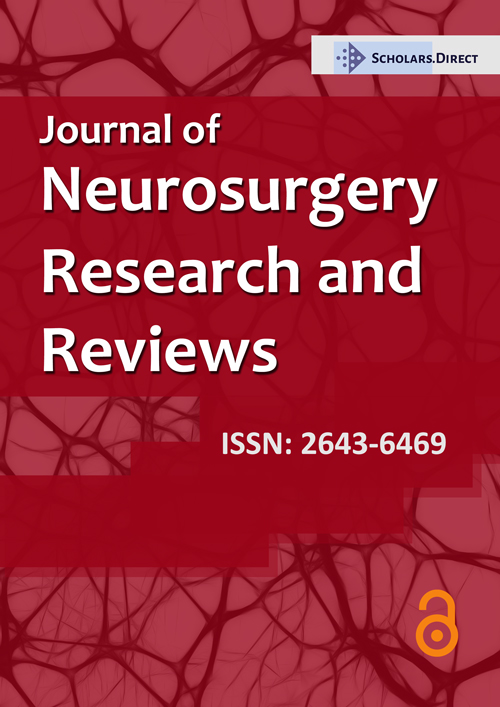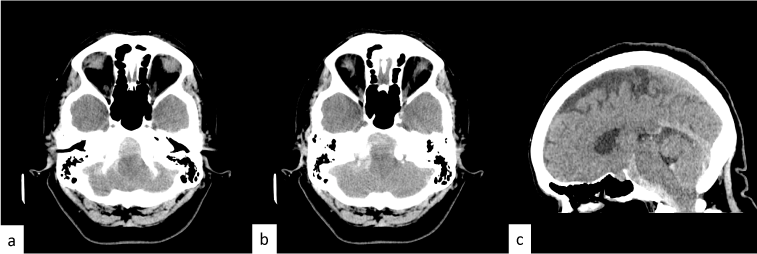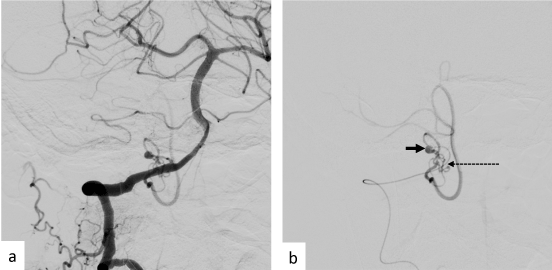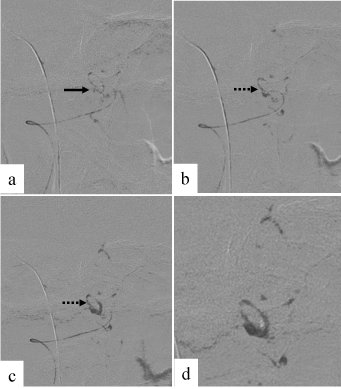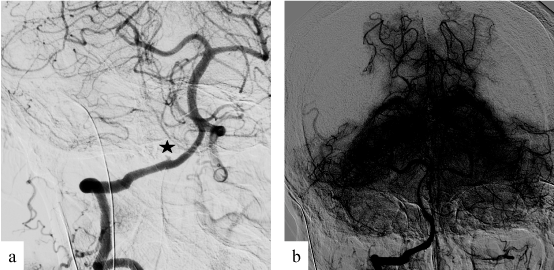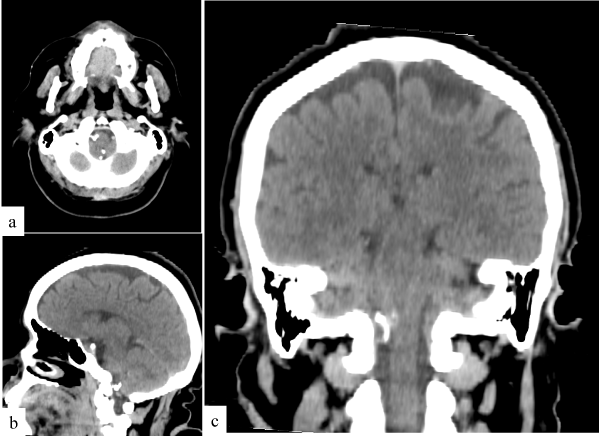Posteroinferior Cerebellar Artery (PICA) Fusiform Aneurysm Ruptured Related with a Pure Arterial Malformation: Case Report and Technical Note (NBCA Embolization under Roadmap-Fluoroscopy)
Abstract
The pure arterial malformation (PAM) lesion has been recently described as a vascular pathology characterized by the sole presence of coiled, sometimes ecstatic, arterial loops.
2% of the fusiform aneurysms are located in the vertebral-posterior inferior cerebellar arteries.
A 60 years old female with subarachnoid hemorrhage was diagnosed with a fusiform aneurysm in the right PICA related with a PAM in the digital subtraction angiography (DSA). With a negative super-selective Wada test; the patient was treated with embolization of the two lesions and the PICA for being in the same arterial territory with adhesive embolic liquid under roadmap fluoroscopy technique.
Conclusion: These two vascular lesions located in the same artery are very rare and more in the PICA territory. Is important to make the best decision to treat them because the potential complications; that's why the procedure were supported with super-selective Wada test and neuromonitoring of the PICA territory.
The injection of the mixture of NBCA and Lipiodol® under roadmap fluoroscopy is very safe.
Keywords
Fusiform aneurysm, Pure arterial malformation, N-butyl cyanoacrylate, Roadmap fluoroscopy
Background
The pure arterial malformation (PAM) lesion has been recently described as a vascular pathology characterized by the sole presence of coiled, sometimes ectaticor arterial loops [1]. These lesions are commonly mistaken for aneurysms or arteriovenous malformations [2].
Dolichoectatic arteries and fusiform aneurysms are related to arteriopathies and connective tissue diseases, andjust 2% of the intracranial aneurysms are located in the vertebral-posterior inferior cerebellar arteries (PICAs) [3].
N-butyl cyanoacrylate (NBCA) is commonly used liquid embolic agent in the endovascular treatment of cerebrovascular and peripheral vascular pathologies. Although NBCA is most commonly known as an endovascular treatment option for cerebral arteriovenous malformation, neurointerventionalist have begun to utilize cyanoacrylate glues for several vascular brain pathologies [4,5].
Case Report
A 60 years old female, with clinical history of hypertension on enalapril twice daily and no allergies reported. She started 5 days previous admission to the hospital with intensive oppressive headache 10/10 of EVA scale, without neurological focalization and no meningeal signs in the physical examination. The head non-contrast CT scan showed subarachnoid hemorrhage grade IV in the Fisher scale. The DSAdemonstrated a fusiform aneurysm and a PAM in the second and third segment of the right PICA respectively (Figure 1). Analyzing the clinical status and the invasive and non-invasive images of the studies of the patient, we decided to embolize the both lesions as well to occlude the PICA for being in the same arterial territory.
The procedure was performed as follows: with the patient awake, analgesia and local anesthesia, neurophysiologic monitoring, super-selective Wada test with 1cc propofol injected in the right PICA obtaining as result, no neurophysiological deficit and clinically did not developed a Wallenberg syndrome.
We proceeded to embolization both lesions and the right PICA with NBCA and Lipiodol. The patient returned to the ICU, and she had a satisfactory clinical evolution and no added neurological deficit, so she was discharged3 days after the treatment.
Embolization Technique
We approached the right femoral artery with a 6F sheath. For the right vertebral hypoplastic artery was used a 5F Chaperon® for the coaxial system with a 1.5 Headway Duo® microcatheter and a Xpedion™ 10 microwire for the super-selective catheterization of the right PICA under roadmap fluoroscopy technique and done a super-selective angiogram (Figure 2) A provocative Wada test was performed with 1 cc of propofol injected in the right PICA supported with neuromonitoring and physical exploration of the patient. The result of the test was negative for a neurological deficit. A load dose of dexamethasone was given intravenously, the microcatheter in optimal position was flushed with 10 cc of 5% glucose solution, the embolization was done with a dilution 1:8 of NBCA and Lipiodol® under roadmap fluoroscopy technique in a Philips Allura (Figure 3).
In the ending rounds of the DSA showed total exclusion of the aneurysm, AM and the right PICA occlusion; the parenchimogramdemonstratedno vascular defects (Figure 4).
The femoral artery was closed with Angioseal® 6F and the control non contrast CT scan did not demonstrate hemorrhage or ischemic stroke (Figure 5).
Discussion
In pure arterial malformations the overlapping, dilated and tortuous trajectory are coil-like appearance in all population ages and may have genetic, infectious, inflammatory, immunological o degenerative predisposing factors that may cause or contribute to the formation and/or progression of the arteriopathy. The appropriate characterization of the vasculopathy architecture is paramount important for choose the best treatment and prognosis varies depending on the type of the vascular anomalies [6].
Aneurysms arising from the PICA distal to the origin from the vertebral artery are rare, represents 0.5 - 3% of all intracranial aneurysms. The fusiform geometry is considered when they had no discernible neck [7]. And PICA aneurysms are most commonly discovered when patients presents subarachnoid hemorrhage (SAH), although patients can occasionally present symptoms related to the medulla and cranial nerves IX - XI. These lesions can be treated by surgery and has several advantages, as immediate decompression by removal the blood clot and identification of the bleeding sources in cases with multiple lesions and decrease the risk of re-ruptured [8,9]. Approximately 20 to 66% of the lower cranial nerve's deficits are associated with open surgery. However, several studies have been published stating the usefulness of endovascular management that avoids the manipulation of the posterior fossa structures [9].
To evaluated a possible infarction of the PICA territory, we used super-selective provocative test with propofol. This anesthetic has a safety margin, low incidence of side effects, and effectiveness in inducing controlled transitory losses of neurologic function in the perfused areas [10,11].
The embolization was done with previous IV load dose of dexamethasone and the microcatheter flushed with 10 cc of 5% glucose. With N-butyl cyanoacrylate (NBCA) and Lipiodol® with a dilution 1:8, under roadmap fluoroscopy technique; the injection of the glue mixture thru the right PICA was for 65 seconds (Figure 4). We showed the good visualization, advance and penetration of the embolic liquid mixture during the injection and excellent control of the reflux at the tip of the microcatheter; thesis important to accomplish the goal of the procedure as well as to choose the right moment for the withdrawal of the microcatheter.
The iodine component of the Lipiodol® determinate it's the radiopacity so during the injection of this embolic material under roadmap fluoroscopy technique and makes unnecessary the addition of tantalum or tungsten for the proper control and visualization during the injection as when using fluoroscopy only.
Lipiodol® has 2 functions: delays the polymerization of the NBCA by shielding it from surrounding ionic substances and the radiopacity during the injection under roadmap fluoroscopy.
The glue composition depends on the hemodynamic characteristics of the targeted lesion to calculated the viscosity of the embolic [12] and the radiopacity adding tantalum or tungsten powder to increase the visibility of the mixture in the conventional fluoroscopy technique [13-15].
Concusion
There is a low incidence of a fusiform and a pure arterial malformation in the same intracranial arterial territory. The endovascular technique is a secure procedure, because during the treatment you can do neurological provocative test and decide the most suitable management.
The utilization of the roadmap fluoroscopy technique during the injection of the mixture of NBCA and Lipiodol®, gives to the operator the visibility of the radiopacity, advance and penetration of the glue as well the reflux at the microcatheter tip without adding tantalum and tungsten.
Acknowledgement
Jorge L. Balderrama Bañares MD. Chief of the Neurological Endovascular Therapy Service of the Neurology and Neurosurgery National Institute. Mexico City.
For his advices for management of complexes clinical cases.
Statement of Ethics
The authors have no ethical conflicts.
Disclosure Statement
The authors have no ethical conflicts.
References
- Thomas J Sorenson, Waleed Brinjikji, Kelly D Flemming, et al. (2018) Pure arterial malformation of the posterior inferior cerebellar artery with interspersed adiposen tissue: Case report. J Neurosurg Pediatr 22: 261-264.
- Brinjikji W, Cloft HJ, Flemming KD, et al. (2018) Pure arterial malformations. J Neurosurgery 129: 91-99.
- Steiger JH, Etmainan N, Hanggi D (2015) Microsurgical brain aneurysms. Springer.
- Cuoco JA, Guilliams EL, Kelin BJ, et al. (2020) N-butyl cyanoacrylate embolization of a traumatic pseudoaneurysm and aretriasvenous fistula of the middle meningeal artery. Radiol Case Rep 15: 321- 325.
- Kim Dh, Lee JY, Jeon HJ, et al. (2015) Intraoperative endovascular embolization of middle memingeal artery and pseudoaneurysm by using N butyl 2 cyanoacrylate for hemostasis during operation of acute epidural hemorrhage. Korean J Neurotrauma 11: 167-169.
- McLaughlin N, Raychev R, Duckwiler G, (2013) Pure arterial malformation of the posterior cerebral artery: Importance of its recognition. J Neurosurg 119: 655 - 660.
- Nussbaum ES, Mendez A, Paul Camarata, et al. (2003) Surgical management of fusiform aneurysms of the peripheral posterioinferior cerebellar artery. Neurosurgery 53: 831 - 835.
- Lewis SB, Chang DJ, Peace DA, et al. (2002) Distal posterior inferior cerebellar artery aneurysms: Clinical features and management. J Neurosurg 97: 756-766.
- Xu F, Hong Y, Zheng Y et al. (2017) Endovascular treatment pf posterior inferior cerebellar artery aneurysms: A 7year single center experience. J Neurointerv Surg 9: 45-51.
- Feliciano CE, De León-Berra R, Hernández Gaitán MS et al. (2010) Provocative test with propofol: Experience in patients with cerebral arteriovenous malformations who underwent neuroendovascular procedures. AJNR Am J Neuroradiol 31: 470-475.
- Curot J, Denuelle M, Busigny T, et al. (2014) Bilateral Wada test: Amobarbital or propofol? Seizure 23: 122-128.
- Gonzalez LF, Albuquerque FC, McDougall C (2015) Neurointerventional techniques. Tricks of the trade.
- n-BCA Trial Investigators (2002) N-Butyl Cyanoacrylate embolization of cerebral arteriovenous malformations: Results of a prospective, randomized, multi-center trial. AJNR Am J Neuroradiol 23: 748-755.
- Tamatani S, Koike T, Ito Y, et al. (2000) Embolization of arteriovenous malformation with diluted mixture of NBCA. Interv Neuroradiol 6: 187-190.
- Takeuchi Y, Morishita H, Sato Y, et al. (2014) Guidelines for the use of NBCA in vascular embolization devised by the Committee of Practice Guidelines of the Japanese Society of Interventional Radiology. J Radiol 32: 500-517.
Corresponding Author
María del Rosario Sosa Martínez MD, Department of Neurosurgery and Neurological Endovascular Therapy, "Lic. Adolfo López Mateos" Regional Hospital of the Security and Social Institute of the State Workers, Universidad #1321 Colonia La Florida, Alcaldía Álvaro Obregón. Ciudad de, Ext 89241, México, Tel: + (55)5322 2300.
Copyright
© 2021 Sosa-Martinez MDR. This is an open-access article distributed under the terms of the Creative Commons Attribution License, which permits unrestricted use, distribution, and reproduction in any medium, provided the original author and source are credited.

